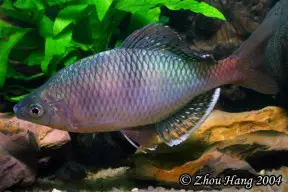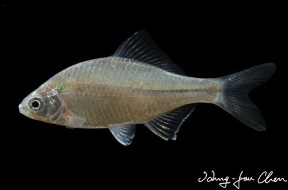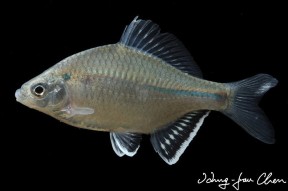Acheilognathus macropterus
Giant Chinese Bitterling
SynonymsTop ↑
Acanthorhodeus macropterus Bleeker, 1870; Acanthorhodeus guichenoti Bleeker, 1871; Acanthorhodeus taenianalis Günther, 1873; Acanthorhodeus dicaeus Rutter, 1897; Acanthorhodeus longispinnis Oshima, 1926; Acanthorhodeus bergi Mori, 1928; Acanthorhodeus ngowyangi Tchang, 1930; Acanthorhodeus jeholicus Mori, 1934
Etymology
Acheilognathus: from the Ancient Greek ἀ- (a-), meaning ‘without’, χείλος (cheílos), meaning ´lip’, and γνάθος (gnáthos), meaning ‘jaw’, because members of this genus lack, or possess only a lateral, labial fold on the lower jaw.
macropterus: from the Ancient Greek μακρός (makrós), meaning ‘long’, and πτερόν (pterón), meaning ‘feather, wing’, presumably in reference to the extended dorsal fin in adult males.
Classification
Order: Cypriniformes Family: Cyprinidae
Distribution
Native to China, the Korean peninsula, northern Vietnam, and southeastern Russia. It has been introduced to, and is considered invasive, in Japan.
In China it’s known from the provinces of Guangdong (Dong and Bei rivers), Hainan Island, Yunnan (Red River) Guangdong (Lianzhou and Yangshan), Jiangxi (Fanyang Lake), Shanghai City, Jiangsu (Tai Lake), Anhui (Linghuaiguan), Hubei (Dong Lake, Liangzi Lake, Hong Lake, Shashi), Hunan (Dongting Lake), Shanxi (Zhouzhi nature reserve), and Heilongjiang (Songhua and Amur rivers).
Type locality is ‘Chang Jiang [Yangtze River], China’.
Habitat
Tends to occur in vegetated, slowly-moving sections of rivers and appears particularly well-adapted to large bodies of standing water, including man-made reservoirs.
Maximum Standard Length
Reports vary wildly with a maximum of 275 mm reported, but typical adult size appears to be 100 – 150 mm.
Aquarium SizeTop ↑
Requires a large aquarium with minimum base dimensions of 180 ∗ 60 cm or equivalent.
Maintenance
An aquarium arranged to resemble a slowly-flowing stream or river with a substrate of variably-sized, water-worn rocks, sand, fine gravel and perhaps some small boulders should suit it best.
This can be further furnished with driftwood roots or branches, and hardy plants such as Microsorum, Bolbitis or Anubias spp. can be grown attached to the décor.
Water Conditions
Temperature: 14 – 22 °C pH: 6.0 – 8.0 Hardness: 36 – 268 ppm
Diet
An omnivore preying on insects and their larvae as well as browsing algae and other vegetation in nature although in the aquarium it’s a largely unfussy feeder and will accept most foods.
A good quality dried product can be used as the staple diet but this should be supplemented with regular meals of small live and frozen fare such as bloodworm, Daphnia, Artemia, etc., for the best colouration and conditioning.
Behaviour and CompatibilityTop ↑
Not aggressive except when breeding, although it seems feasible that much smaller tankmates may be eaten by adults.
It should do well alongside similarly-sized, peaceful fishes that require comparable environmental conditions such as Zacco, Sarcocheilichthys, Cobitis, or Rhinogobius species.
Sexual Dimorphism
Males possess more extended rays in the dorsal and anal fins than females, while nuptial males display an overall more intense colour pattern, with a pale pink metallic lustre, darkened abdomen, breeding tubercules on the snout, and white spots on the anal-fin.
In nuptial females the normally colourless anal-fin becomes yellow and an ovipositor which may exceed 80 mm in length appears prior to spawning.
Reproduction
Bitterlings (see ‘Notes’) exhibit an unusual spawning symbiosis in which the interlamellar spaces of the paired inner and outer gills of living unionid mussels are used as a spawning substrate.
During the reproductive period females develop a long ovipositor which is used to deposit eggs through the mussel’s exhalant siphon. Males then move in to males release milt into the mussels’ inhalant siphon in order to fertilize them while aggressively defending the area against other males. The embryos and emergent fry possess characteristic morphology, physiology, and behaviour, which enables them to remain in the host mussel until they swim free after 2-6 weeks, depending on species.
Adult females tend to spawn in more than a single mussel during each spawning season, and multiple clutches from several females of one or more bitterling species may be hosted in a single mussel.
Although most bitterlings spawn in spring a few Acheilognathus species do so in autumn, with the hatched embryos exhibiting arrested development during winter. Studies suggest this to represent a genetically determined diapause and that all species adopting this strategy evolved from a common ancestor.
Since the native mussel species used by A. macropterus during reproduction is unknown, captive reproduction seems unlikely at present, although it may prove adaptable since some bitterlings are host-specific whereas others are not. In Lake Kasumigaura, Japan, where it is considered invasive, it is known to use a native bivalve, Unio douglasiae, for example.
NotesTop ↑
A. macropterus appears in the ornamental trade on an irregular basis and should only be considered by more experienced aquarists with sufficiently large facilities.
It is the type species of the currently invalid genus Acanthorhodeus of which members are separated from other acheilognathids by possession of markedly more dorsal and anal branched rays (15-18 and 10-14, respectively) and a thickened last dorsal-fin ray which is only flexible at the distal extreme.
Given its wide geographical distribution there is a possibility that it represents a group of closely-related species, with genetic studies indicating the existence of several distinct clades. Its definition is thus somewhat vague, but is summarised by the following series of characters: short barbels present or absent; lateral line complete; lateral line scales 35-39; branched dorsal fin rays 15 – 18; branched anal fin rays 11 – 14; dorsal surface grey, flanks silvery; breeding males slightly pink; a greyish lateral stripe extending anteriorly from caudal peduncle; a blackish spot at upper extremity of opercle, may be faded in nuptial males; anal-fin in males with white distal border; anal-fin in female mostly colourless with whitish tips on some rays; pelvic-fin rays with whitish tips in both sexes, more prominent in males.
The genus Acheilognathus contains at least 39 valid species and is thus the most diverse within the nominal subfamily Acheilognathinae (see below). Members of Acheilognathus are identified by the following combination of shared characters: body compressed, rhomboid, or moderately elongate; depth of body almost 2/3 in its standard length; head small, its length about 1/2 in body depth; lateral line complete or incomplete; barbels absent or present; branched dorsal-fin rays 8–18, branched anal-fin rays 7–14; number of branched dorsal-fin rays minus number of branched anal-fin rays –1-5; serration of pharyngeal teeth developed; two white transverse bands on dorsal-fin rays in both males and females; diploid chromosome number 42 or 44; wing-like yolk sac projection not developed.
Acheilognathins comprise a group of fishes most commonly referred to as bitterlings, the majority of which are found in eastern Asia with two in Europe. Although the taxonomical composition of this assemblage has been a subject of debate, most researchers now agree that there are three genera; Acheilognathus, Rhodeus, and Tanakia. The number of species is less certain with conflicting estimates ranging from 45-70.
Preliminary genetic research suggests the existence of two major clades, one comprising a monophyletic Acheilognathus and the other Rhodeus and Tanakia, both of which are probably paraphyletic.
All bitterlings reproduce using bivalve mussels as an intermediate host for eggs and fry, and this is a particular conservation concern given the ongoing deterioration of freshwater habitats throughout their range since these hosts typically require good water quality.
References
- Bleeker, P., 1871 - Verhandelingen der Koninklijke Akademie van Wetenschappen (Amsterdam) v. 12 (art. 2): 1-91
Mémoire sur les cyprinoïdes de Chine. - Arai, R., H. Fujikawa and Y. Nagata, 2007 - Bulletin of the National Museum of Nature and Science (Ser. A) Suppement No. 1: 1-28
Four new subspecies of Acheilognathus Bitterlings (Cyprinidae: Acheilognathidae) from Japan. - Cheng, P., D. Yu, S. Liu, Q. Tang, and H. Liu, 2014 - Zoological Science 31(5): 300-308
Molecular Phylogeny and Conservation Priorities of the Subfamily Acheilognathinae (Teleostei: Cyprinidae). - Hagiwara, T., 2008 - In: Sengupta, M. and R. Dalwani (eds). Proceedings of Taal 2007: The 12th World Lake Conference: 1082-1087
The invasion of Japan by an exotic bitterling, Aceilognathus macropterus, and its effects. - Kawamura, K. and K. Uehara, 2005 - Journal of Fish Biology 67(3): 684-695
Effects of temperature on free‐embryonic diapause in the autumn‐spawning bitterling Acheilognathus rhombeus (Teleostei: Cyprinidae). - Kawamura, K., T. Ueda, R. Awai, and C. Smith, 2014 - Zoological Science 31(5): 321-329
Phylogenetic Relationships of Bitterling Fishes (Teleostei: Cypriniformes: Acheilognathinae), Inferred from Mitochondrial Cytochrome b Sequences. - Kottelat, M., 2013 - The Raffles Bulletin of Zoology Supplement 27: 1-663
The fishes of the inland waters of southeast Asia: a catalogue and core bibiography of the fishes known to occur in freshwaters, mangroves and estuaries. - Kottelat, M., 2001 - Environment and Social Development Unit, East Asia and Pacific Region. The World Bank: i-iii + 1-123 + 1-18
Freshwater fishes of northern Vietnam. A preliminary check-list of the fishes known or expected to occur in northern Vietnam with comments on systematics and nomenclature. - Reichard, M., J. Bryja, M. Polačik, and C. Smith, 2011 - Molecular Ecology 20(17): 3631-3643
No evidence for host specialization or host‐race formation in the European bitterling (Rhodeus amarus), a fish that parasitizes freshwater mussels. - Yang, Q., Y. Zhu, B. Xiong and H. Liu, 2011 - Zoological Science 28(2): 158-167
Acheilognathus changtingensis sp. nov., a new species of the cyprinid genus Acheilognathus (Teleostei: Cyprinidae) from southeastern China based on morphological and molecular evidence. - Zhu, Y. and H. Liu., 2007 - Frontiers of Biology in China 2(4): 450-455
Genetic diversity and the biogeographical process of Acheilognathus macropterus revealed by sequence variations of mitochondrial cytochrome b gene.



